How Soviet ICBMs liquidated American air defense systems
After the start of the Cold War, the United States tried to gain military superiority over the USSR. The Soviet ground forces were very numerous and equipped with modern military equipment and weapons by the standards of the day, and the Americans and their closest allies could not hope to defeat them in the ground operation. At the first stage of the global confrontation, the stake was placed on American and British strategic bombers, which were supposed to destroy the most important Soviet administrative, political and industrial centers. The American plans for the war against the USSR provided that after atomic strikes against the most important administrative and political centers by large-scale bombing using conventional bombs, it would be possible to undermine the Soviet industrial potential and destroy the most important naval bases and airfields. It should be recognized that until the mid-1950s, American bombers had rather high chances of successfully bombing in Moscow and other major Soviet cities. Nevertheless, the destruction of even 100% of the goals set by American generals did not solve the problem of the superiority of the USSR in conventional weapons in Europe and did not guarantee victory in the war.
At the same time, the possibility of Soviet long-range bomber aviation in the 1950s were quite modest. The adoption of the Tu-4 bomber in the Soviet Union, which could have been the carrier of an atomic bomb, did not provide "nuclear retaliation." Tu-4 piston bombers did not have an intercontinental flight range, and if an order was issued to strike North America for their crews, it was one-way flight, with no chance of return.
Nevertheless, the American military-political leadership after the successful test of the first Soviet nuclear charge in 1949 was seriously concerned about the protection of the US territory from Soviet bombers. At the same time as the deployment of radar monitoring tools, the development and production of jet fighter interceptors, the creation of anti-aircraft missile systems was carried out. It was the anti-aircraft missiles that were to become the last frontier of defense, in the event that bombers with atomic bombs on board break through to protected objects through the barriers of interceptors.
The first American anti-aircraft missile system, adopted in 1953, was SAM-A-7. This complex, created by Western Electric, since July 1955 was called NIKE I, and in 1956 it received the designation MIM-3 Nike Ajax.
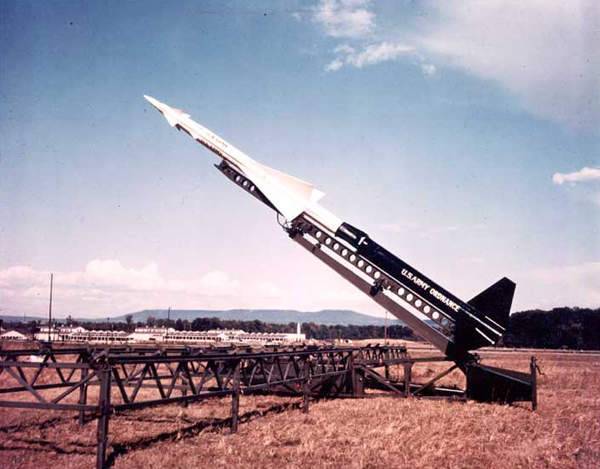
The main engine of the anti-aircraft missile was powered by liquid fuel and an oxidizer. The launch was carried out using a detachable solid fuel accelerator. Guidance on the target is a radio command. The data supplied by target tracking and tracking radars about the target’s airborne position and missiles in the air was processed by a counting and solving device built on electrovacuum devices. The missile warhead was undermined by a radio signal from the ground at the calculated point of the trajectory.
The mass of the rocket prepared for use was 1120 kg. Length - 9,96 m. Maximum diameter - 410 mm. The inclined range of the Nike Ajax defeat is up to 48 kilometers. The ceiling is about 21000 m. The maximum flight speed is 750 m / s. Such characteristics made it possible to intercept any long-range bomber that existed in the 1950s after entering the affected area.
SAM "Nike Ajax" was purely stationary and included capital facilities. The anti-aircraft battery consisted of two parts: a central control center, where concrete bunkers for anti-aircraft calculations were located, radars for detection and guidance, counting and decisive equipment, and a technical launching pad, which housed launchers, protected rocket stores, tanks with fuel and oxidizer .
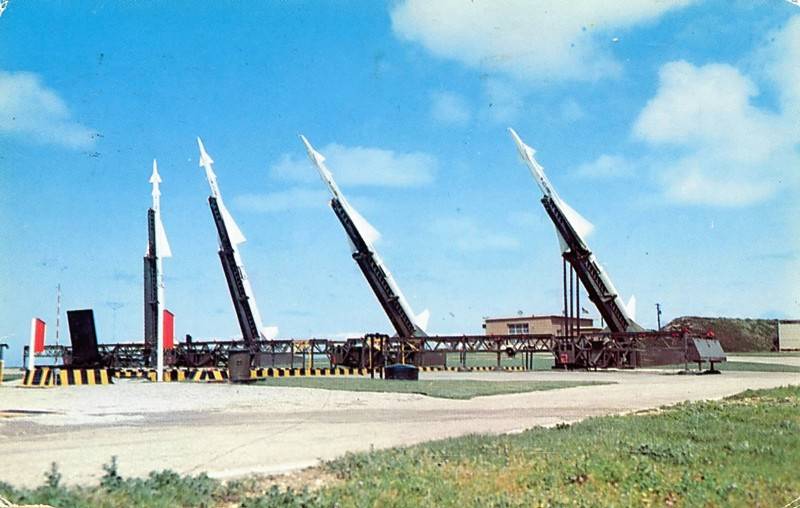
The original version provided for 4-6 launchers, dual missile ammunition in the storage. Spare missiles were in sheltered shelters in the filled state and could be served on launchers within 10 minutes.
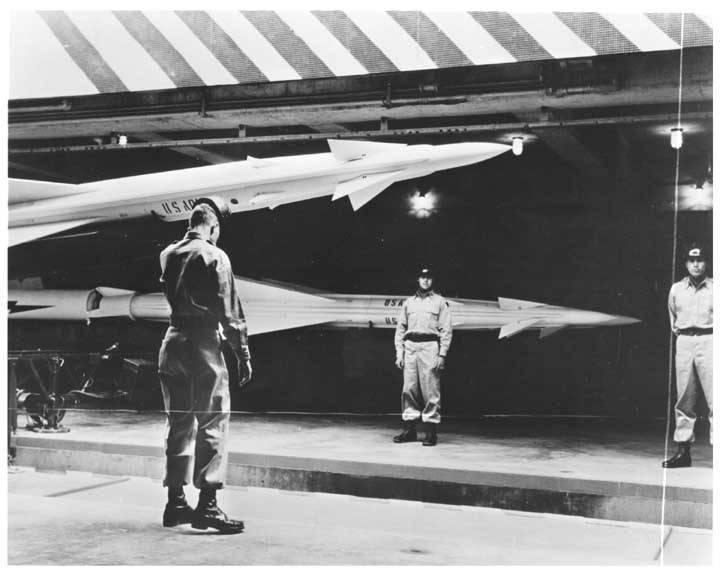
However, as it was deployed, taking into account a sufficiently long reload time and the possibility of simultaneous attack of one object by several bombers, it was decided to increase the number of launchers at one position. In the immediate vicinity of strategically important objects: naval and air bases, large administrative, political and industrial centers, the number of missile launchers at a position reached 12-16 units.
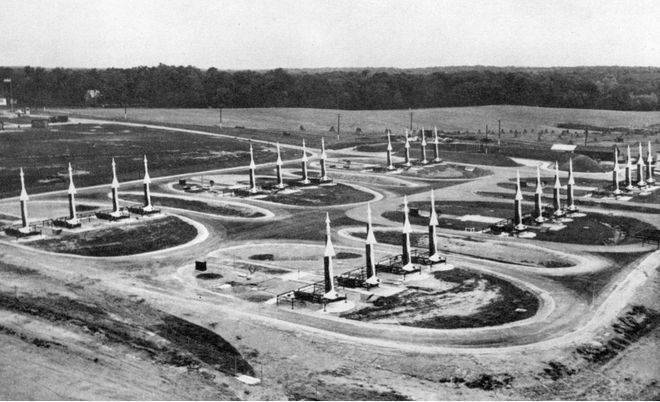
Significant funds were allocated in the United States for the construction of fixed installations for anti-aircraft missile systems. As of 1958, more than 100 MIM-3 Nike-Ajax positions were deployed. However, taking into account the rapid development of military aviation in the second half of the 1950s, it became clear that the Nike Ajax air defense system is becoming obsolete and will not be able to meet modern requirements in the next decade. In addition, during operation, refueling and servicing missiles with an engine running on explosive and toxic fuel and a caustic oxidizer caused great difficulties. The US military was also not satisfied with the low noise immunity and the impossibility of centralized control of anti-aircraft batteries. In the late 1950s, the problem of automated control was solved by the introduction of Martin's AN / FSG-1 Missile Master system, which made it possible to exchange information between the calculating and resolving devices of individual batteries and to coordinate the distribution of targets between several batteries from a regional air defense missile control system. However, improving team manageability did not address other shortcomings. After a series of serious incidents involving fuel and oxidizer leaks, the military demanded the speedy development and adoption of an anti-aircraft complex with solid-fuel missiles.
In 1958, Western Electric brought the anti-aircraft missile system originally known as SAM-A-25 Nike B. to mass production. After the mass deployment of air defense systems, they received the final name MIM-14 Nike-Hercules.
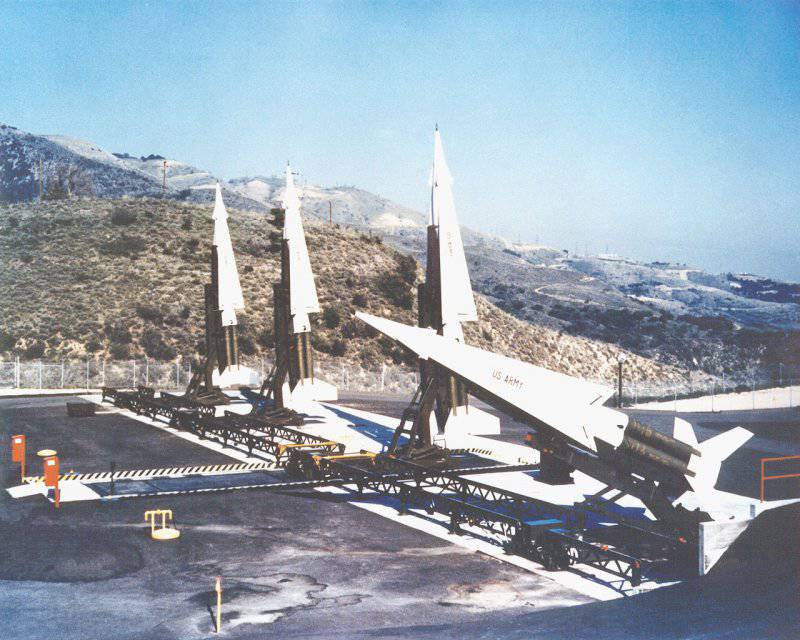
The first version of the MIM-14 Nike-Hercules SAM for a number of elements had a high degree of continuity with the MIM-3 Nike Ajax. The schematic diagram of the construction and combat operation of the complex remained the same. The detection and target designation system of the Nike-Hercules air defense system was originally based on a stationary detection radar from the Nike-Ajax air defense system operating in the mode of continuous emission of radio waves. However, more than doubled the firing range required the development of more powerful stations for detecting, tracking and guiding anti-aircraft missiles.
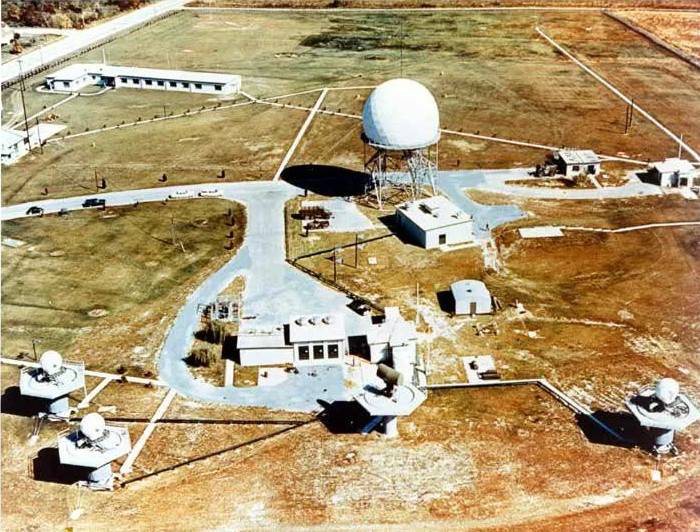
SAM MIM-14 Nike-Hercules, like MIM-3 Nike Ajax was single-channel, which significantly limited the ability to reflect a massive raid. This was partly offset by the fact that in some areas of the United States anti-aircraft positions were placed very tightly and there was the possibility of mutual overlapping of the affected area. In addition, the armament of Soviet long-range aviation was not so many bombers with intercontinental flight range.
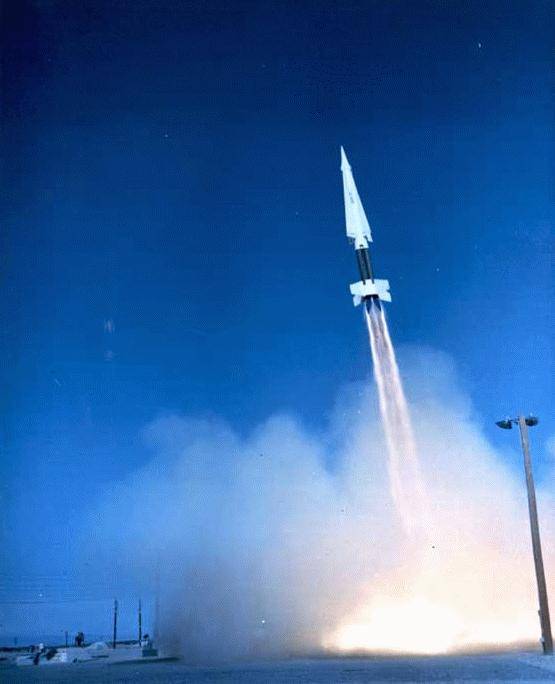
The solid-propellant missiles used in the MIM-14 Nike-Hercules air defense system have become larger and heavier than the MIM-3 Nike Ajax missiles. The weight of the fully equipped MIM-14 rocket was 4860 kg, length - 12 m. The maximum diameter of the first stage is 800 mm, the second stage is 530 mm. Wingspan 2,3 m. The defeat of the air target was carried out 502 kg fragmentation warhead. The maximum firing range of the first modification was 130 km, the ceiling - 30 km. In the later version, the firing range for large high-altitude targets brought up to 150 km. The maximum speed of the rocket is 1150 m / s. The minimum range and altitude of hitting a target flying at a speed of up to 800 m / s are 13 and 1,5 km, respectively.
In the 1950s and 1960s, the American military leadership believed that nuclear weapons could solve a wide range of problems. It was proposed to use nuclear artillery shells to destroy group targets on the battlefield and against the enemy’s defense line. Tactical and operational-tactical ballistic missiles were designed to solve problems at a distance of several tens to hundreds of kilometers from the line of contact. Nuclear landmines were to create impenetrable blockages on the path of the offensive of enemy troops. For use against surface and underwater targets, torpedoes and depth charges were equipped with atomic charges. Relatively small warheads were installed on aircraft and anti-aircraft missiles. The use of nuclear warheads against air targets made it possible not only to successfully deal with group targets, but also to compensate for errors in aiming at the target. Anti-aircraft missiles of the Nike-Hercules complexes were equipped with nuclear warheads: W7 - with a power of 2,5 kt and W31 with a power of 2, 20 and 40 kt. An air blast of a 40-kt nuclear warhead could destroy an aircraft within a radius of 2 km from the epicenter, which would effectively destroy even complex, small-sized targets like supersonic cruise missiles. More than half of the MIM-14 missiles deployed in the United States were equipped with nuclear warheads. It was planned to use anti-aircraft missiles carrying nuclear warheads against group targets or in a difficult jamming environment when precise guidance on the target was impossible.
To deploy the Nike-Hercules air defense system, the old Nike-Ajax positions were used and new ones were actively built. By 1963, the MIM-14 Nike-Hercules solid-fuel systems had finally supplanted the MIM-3 Nike Ajax missile systems with liquid rockets in the United States.

In the early 1960s, the MIM-14B, which is also known as Improved Hercules, was created and mass-produced. Unlike the first option, this modification had the ability to relocate within a reasonable time, and it could be called mobile with some stretch. Advanced Hercules’s radars could be transported on wheeled platforms, and the launchers were collapsible.
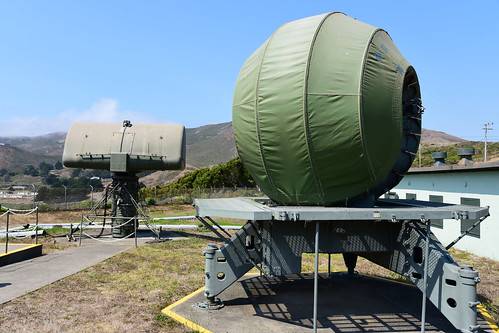
In general, the mobility of the MIM-14B air defense system was comparable to the Soviet long-range S-200 complex. In addition to the possibility of changing the firing position, the modernized MIM-14V air defense systems introduced new detection radars and improved tracking radars, which increased the noise immunity and the ability to track high-speed targets. An additional radio range finder continuously determined the distance to the target and issued additional corrections for the computer. A part of the electronic units was transferred from electric vacuum devices to a solid-state elemental base, which reduced energy consumption and increased reliability. In the mid-1960s, for the MIM-14В and MIM-14С modifications, SAM was introduced with a firing range of up to 150 km, which at that time was very high for a complex in which a solid-fuel rocket was used.
Serial production of the MIM-14 Nike-Hercules continued until 1965. In total, 393 ground-based anti-aircraft systems and about 25000 anti-aircraft missiles were launched. In addition to the United States, licensed production of the MIM-14 Nike-Hercules was in Japan. In total, by the mid-1960s, 145 Nike-Hercules anti-aircraft batteries were deployed in the United States (35 were rebuilt and 110 were converted from Nike-Ajax positions). This made it possible to effectively cover the main industrial areas, administrative centers, ports, and air and naval bases from bombers. However, anti-aircraft missile systems of the Nike family were never the main means of air defense, but were considered only as an addition to the numerous fighter-interceptors.
At the time the Caribbean crisis began, the United States significantly outstripped the Soviet Union in the number of nuclear warheads. Taking into account carriers deployed at American bases in the immediate vicinity of the borders of the USSR, Americans could use about 3000 charges for strategic purposes. Soviet carriers capable of reaching North America had about 400 charges, deployed mainly on strategic bombers.
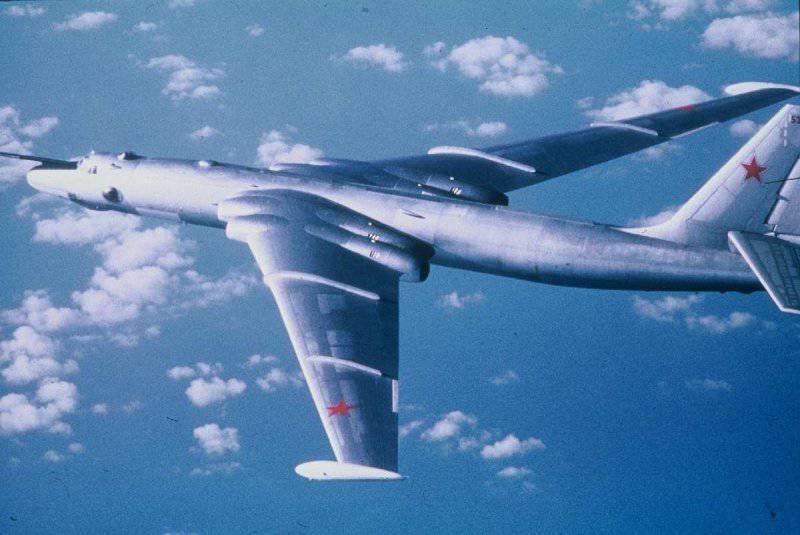
More than 200 long-range Tu-95, 3M, M-4 bombers, as well as about 25 R-7 and R-16 intercontinental ballistic missiles, could participate in the strike on US territory. Given that Soviet long-range aviation, unlike the American one, did not practice combat duty in the air with nuclear bombs on board, and Soviet ICBMs required long prelaunch preparations, bombers and missiles could be destroyed with a high probability by a surprise strike at locations. Soviet diesel submarines with ballistic missiles pr.629 while on combat patrols mainly posed a threat to American bases in Western Europe and the Pacific Ocean. By October 1962, the USSR Navy had five nuclear missile boats of Project 658, but in terms of number and range of missile launch, they were significantly inferior to nine American SSBNs of the type of George Washington and Ethan Allen.
An attempt to deploy medium-range ballistic missiles in Cuba put the world on the brink of a nuclear disaster, and although in exchange for the withdrawal of Soviet missiles from Liberty Island, the Americans eliminated the Jupiter ballistic missile launch positions in Turkey, our country was much inferior to the United States in strategic weapons in the 1960s . But even in this situation, the American top military-political leadership wanted to guarantee the protection of the United States from nuclear retaliation by the USSR. To this end, with the acceleration of anti-ballistic missile defense, continued further strengthening of the US and Canada air defense systems.
Long-range anti-aircraft systems of the first generation could not fight low-altitude targets, and their powerful surveillance radars were not always able to detect aircraft and cruise missiles hiding behind the folds of the terrain. There was a possibility that Soviet bombers or cruise missiles launched from them would be able to overcome low-level air defense lines. Such fears were completely justified, according to information declassified in the 1990s, in the early 1960s, in order to develop new, more effective methods of air defense breakthrough, specially trained Tu-95 bombers performed flights at altitudes below the visibility range of the PLC of that period.
To combat low-altitude air attack in 1960, the U.S. Army adopted the MIM-23 Hawk SAM. Unlike the Nike family, the new complex was immediately developed in a mobile version.
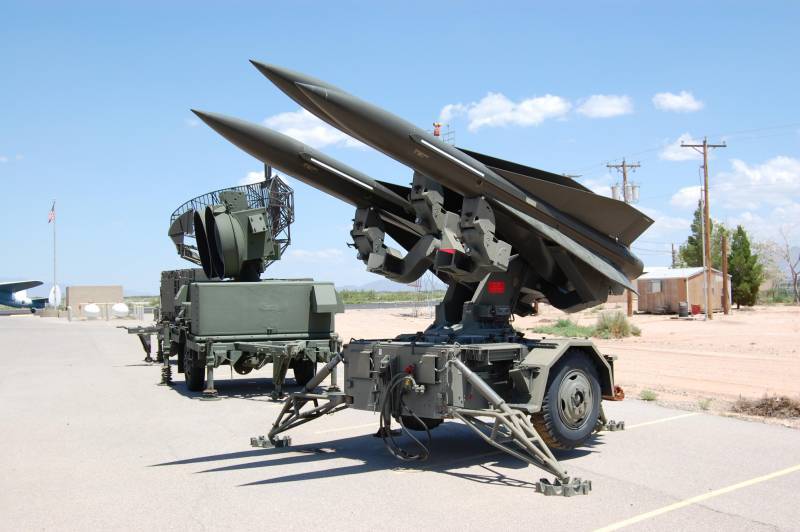
The anti-aircraft battery, consisting of three firing platoons, included: 9 towed launchers with 3 SAMs on each, a surveillance radar, three target illumination stations, a central battery control center, a portable console for firing fire section remote control, a platoon command post, as well as a transport -charging machines and diesel generator power plants. Soon after being adopted, a radar specially designed for detecting low-altitude targets was added to the complex. In the first modification of the Hawk air defense system, a solid-fuel missile with a semi-active homing head was used, with the possibility of firing at air targets at a range of 2-25 km and altitudes of 50-11000 m. The probability of hitting a target with one missile in the absence of interference was 0,55.
It was assumed that the Hawk air defense system would cover gaps between the long-range Nike-Hercules air defense systems and exclude the possibility of bombers breaking through to guarded objects. But by the time the low-altitude complex reached the required level of combat readiness, it became clear that the main threat to objects in the United States was not bombers. However, several Hawk batteries were deployed on the coast, as American intelligence received information about the introduction of cruise missile submarines into the USSR Navy. In the 1960s, the likelihood of nuclear strikes against US coastal regions was high. Basically, the "Hawks" were deployed at advanced American bases in Western Europe and Asia, in those areas where Soviet front-line combat aircraft could fly.
In the mid-1950s, US military analysts predicted the appearance in the USSR of long-range cruise missiles launched from submarines and strategic bombers. I must say that American experts were not mistaken. In 1959, the P-5 cruise missile with a nuclear warhead with a capacity of 200-650 ct was adopted. The cruise missile launch range was 500 km, the maximum flight speed - about 1300 km / h. P-5 missiles were armed with diesel-electric submarines, pr. 644, pr. 665, pr. 651, as well as nuclear pr. 659 and pr. 675.
A much greater threat to facilities in North America was the Tu-95K strategic missile-carrying aircraft equipped with X-20 cruise missiles. This missile with a launch range of up to 600 km developed a speed of more than 2300 km / h and carried a thermonuclear warhead with a capacity of 0,8-3 Mt.
Like the naval P-5, the X-20 aircraft cruise missile was intended to destroy large area targets, and could be launched from a carrier aircraft before it entered the enemy’s air defense zone. By 1965, 73 Tu-95K and Tu-95KM aircraft were built in the USSR.
Intercepting a missile carrier to the turn of a cruise missile launch was a very difficult task. After detecting the CD carrier by radars, it took time to bring the fighter-interceptor to the intercept line, and he simply could not have time to take an advantageous position for this. In addition, a fighter flight at supersonic speed required the use of afterburner, which in turn led to increased fuel consumption and limited flight range. Theoretically, the Nike-Hercules air defense missile systems were able to successfully deal with high-altitude supersonic targets, but the positions of the complexes were often located in the immediate vicinity of the objects to be covered, and in the event of missed missed missiles or time for re-shelling the target, there might not be enough time.
Wanting to play it safe, the US Air Force initiated the development of a supersonic unmanned interceptor, which was supposed to meet enemy bombers on distant approaches. I must say that the command of the ground forces in whose command were the air defense systems of the Nike family and the leadership of the air force adhered to different concepts of building the air defense of the country. According to ground generals, important objects: cities, military bases, industry, each had to hide behind their own batteries of anti-aircraft missiles, tied into a common control system. Representatives of the Air Force insisted that the "object defense" in the atomic age weapons is not reliable, and they proposed a long-range unmanned interceptor capable of carrying out "territorial defense" - preventing enemy aircraft from being close to defended objects. An economic evaluation of the project proposed by the Air Force has shown that it is more expedient, and will come out about 2,5 times cheaper with the same probability of defeat. At the same time, less personnel was required, and a large territory was defended. However, at the congressional hearings both options were approved. Manned and unmanned interceptors had to meet bombers with nuclear free-falling bombs and cruise missiles at distant approaches, and air defense systems - to finish off the targets that had broken through to the guarded objects.
Initially, it was assumed that the complex would be integrated with the existing early warning radars of the combined US-Canadian North American Air Defense Command NORAD (North American Air Defense Command), and the SAGE system - a system of semi-automatic coordination of interceptor actions by programming their autopilots via radio-based computers on the ground. The SAGE system, which worked according to the NORAD radar data, provided the interceptor to the target area without a pilot. Thus, the Air Force only needed to develop a missile integrated into an existing interceptor guidance system. In the mid-1960s, more than 370 ground-based radars functioned as part of NORAD, supplying information to 14 regional air defense command centers, dozens of AWACS aircraft and radar patrol ships were on duty every day, and the US-Canadian interceptor fighter fleet exceeded 2000.
From the very beginning, the XF-99 unmanned interceptor was designed for reusable use. It was assumed that immediately after launch and climb, the heading and flight altitude will be automatically coordinated by the commands of the SAGE control system. Active radar homing turned on only when approaching the target. The unmanned vehicle was supposed to use air-to-air missiles against attacked aircraft, after which it would make a soft landing using a parachute rescue system. However, subsequently, in order to save time and reduce costs, it was decided to build a one-time interceptor, equipping it with a fragmentation or nuclear warhead with a capacity of about 10 kt. A nuclear charge of such power was enough to destroy an aircraft or a cruise missile with a missile intercept of 1000 m. Later on, to increase the probability of hitting a target, warheads of 40 to 100 ct were used. Initially, the complex was designated XF-99, then IM-99, and only after adopting the CIM-10A Bomars.
Flight tests of the complex began in 1952, it entered service in 1957. Serially, aircraft-shells were manufactured by Boeing from 1957 to 1961. In total, 269 interceptors of modification “A” and 301 modifications of “B” were manufactured. Most of the deployed Bomarks were equipped with nuclear warheads.
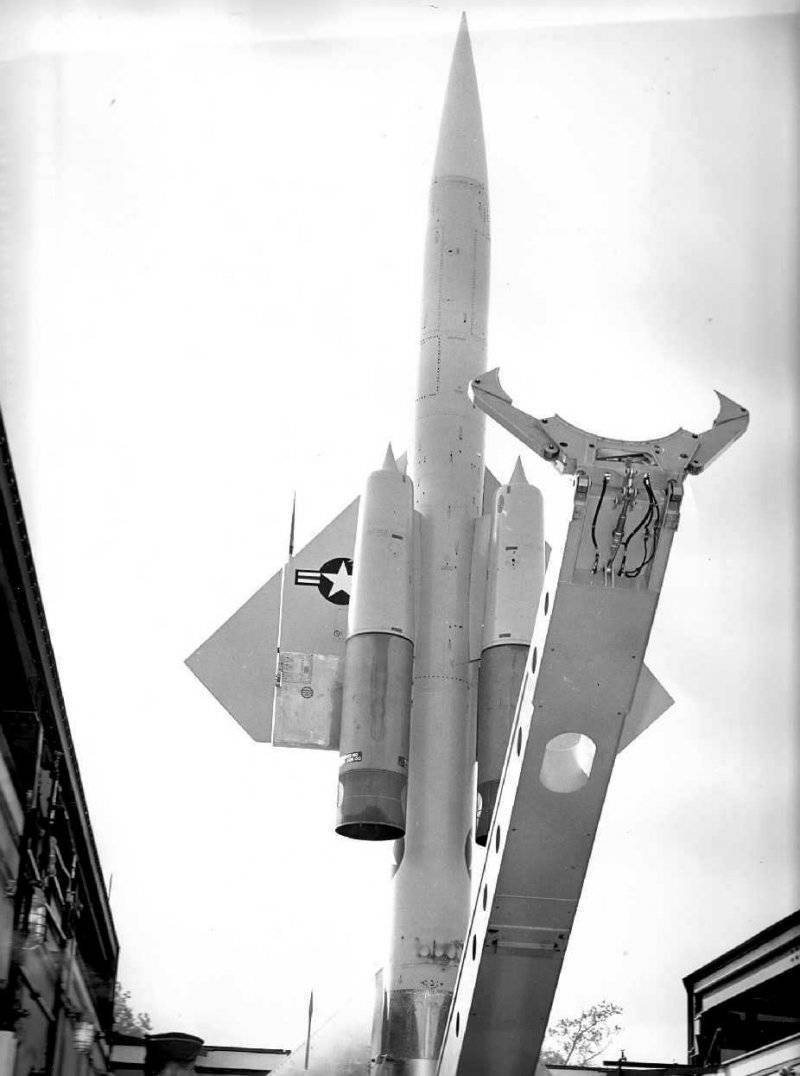
The CIM-10 Bomars unmanned interceptor was a normal projectile projectile (cruise missile) of a normal aerodynamic design, with steering surfaces placed in the rear. The launch was carried out vertically, using a liquid launch accelerator, accelerating the aircraft to a speed of 2M. The starting accelerator for the modification “A” rocket was a liquid fuel engine operating on kerosene with the addition of asymmetric dimethylhydrazine; the oxidizing agent was dehydrated nitric acid. Starting engine operating time - about 45 sec. He allowed to reach a height of 10 km and accelerated the rocket to a speed at which two marching ramjet engines running on gasoline with an octane rating of 80 were turned on.
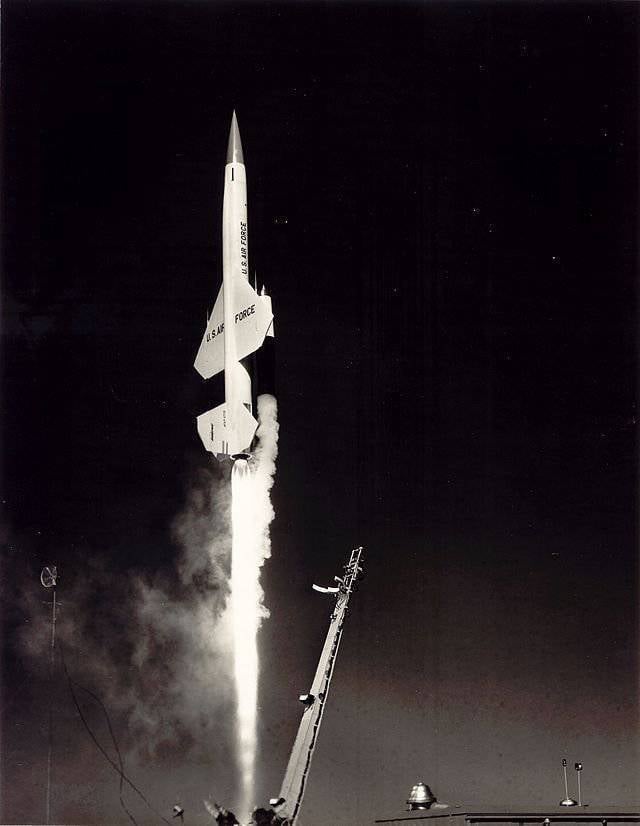
After launch, the projectile vertically climbed the height of the cruise flight, then turns to the side of the target. The SAGE guidance system processed the data of the locators and transmitted them via cables (laid underground) to relay stations, near which the interceptor was flying at that moment. Depending on the maneuvers of the intercepted target, the flight path in this section could be adjusted. The autopilot received data on changes in the enemy’s course, and coordinated its course in accordance with this. When approaching the target, on command from the ground, a homing head was activated, operating in a pulsed mode in the centimeter frequency range.
The CIM-10A modification interceptor was 14,2 m long and had a wingspan of 5,54 m. Starting weight was 7020 kg. The flight speed is about 3400 km / h. Flight height - 20000 m. Combat radius - up to 450 km. In 1961, an improved version of the CIM-10B was adopted. Unlike modification “A”, the projectile-shell of modification “B” had a solid fuel launch accelerator, improved aerodynamics and a more advanced onboard homing radar operating continuously. The radar mounted on the CIM-10B interceptor could capture a fighter target flying against the background of the earth at a distance of 20 km. Thanks to new direct-flow engines, the flight speed increased to 3600 km / h, combat radius - up to 700 km. The interception height is up to 30000 m. Compared to the CIM-10A, the CIM-10B interceptor was heavier by about 250 kg. In addition to the increased speed, range and altitude, the improved model has become significantly safer to operate and easier to maintain. The use of solid fuel accelerators made it possible to abandon the toxic, caustic, and explosive components used in the CIM-10A first stage rocket engine.
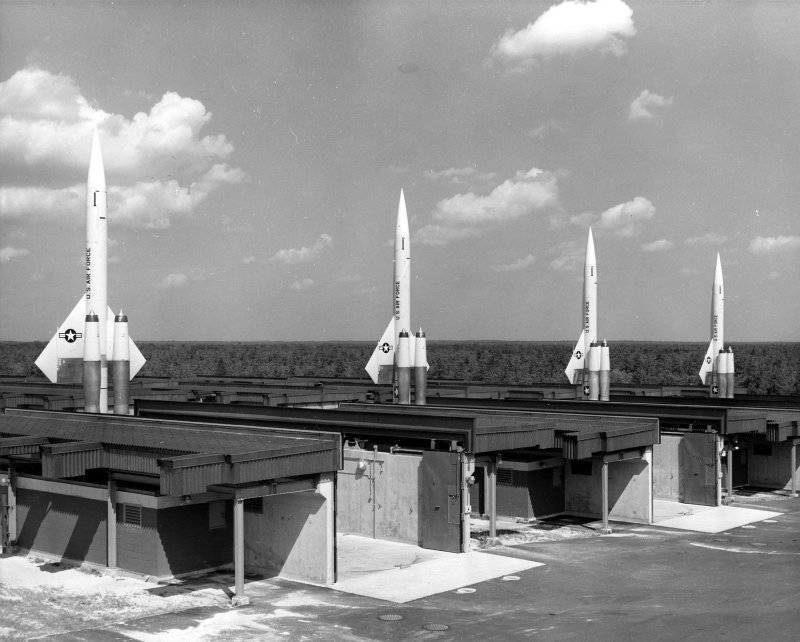
Interceptors were launched from block reinforced concrete shelters located on well-protected bases, each of which was equipped with a large number of installations.
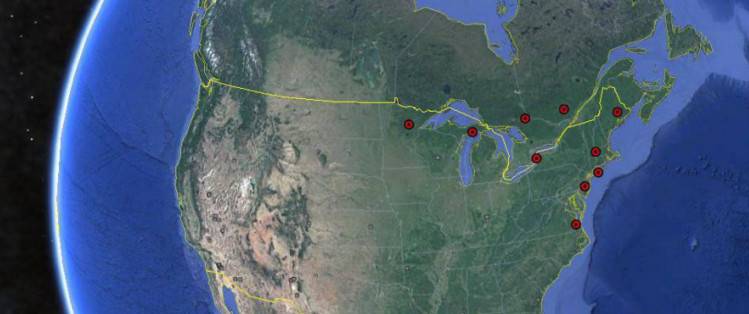
The original plan, adopted in 1955, provided for the deployment of 52 missile bases with 160 interceptors on each. This was supposed to completely cover the territory of the United States from an air attack by Soviet long-range bombers and cruise missiles.
By 1960, 10 positions were deployed: 8 in the United States and 2 in Canada. The deployment of launchers in Canada is connected with the desire of the U.S. Air Force command to push the intercept line as far as possible from its borders, which was especially important in connection with the use of powerful thermonuclear warheads on unmanned interceptors.
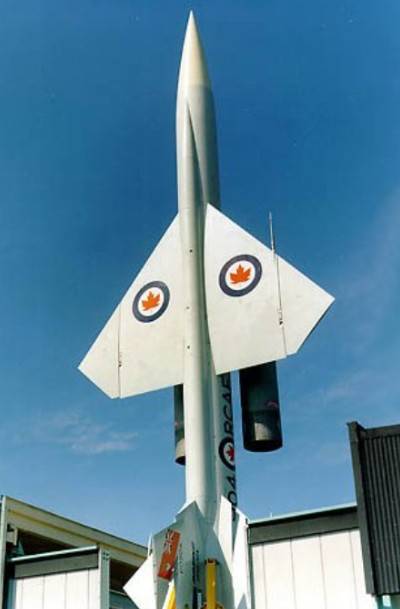
The first Bomark squadron was deployed to Canada on December 31, 1963. "Beavers" were formally listed in the arsenal of the Canadian Air Force, although they were considered the property of the United States and were on alert under the supervision of American officers. This ran counter to Canada’s nuclear-free status and provoked local protests.
The North American air defense system reached its peak in the mid-1960s, and it seemed that it could guarantee the United States safe from Soviet long-range bombers. However, subsequent events showed that many of the billions in costs were actually thrown into the wind. The massive deployment in the USSR of intercontinental ballistic missiles capable of guaranteed delivery of military units of the megaton class to the United States has devalued the American air defense. In this case, we can say that the billions of dollars spent on the development, production and deployment of expensive air defense systems were wasted.
The first Soviet ICBM was the two-stage R-7, equipped with a thermonuclear charge with a capacity of about 3 MT. The combat alert for the first launch complex took place in December 1959. In September 1960, the R-7A ICBM was adopted. She had a more powerful second stage, which allowed to increase the firing range and a new warhead. There were six launch pads in the USSR. The engines of the R-7 and R-7A rockets worked on kerosene and liquid oxygen. Maximum firing range: 8000-9500 km. KVO - more than 3 km. The thrown weight: to 5400 kg. Starting weight - more than 265 tons.
The prelaunch process lasted about 2 hours, and the ground launch complex itself was very bulky, vulnerable and difficult to operate. In addition, the batch layout of the first-stage engines made it impossible to place the rocket in a buried mine, and a radio correction system was used to control the rocket. In connection with the creation of more advanced ICBMs, in 1968 the R-7 and R-7A missiles were withdrawn from service.
The two-stage R-16 ICBM on high-boiling fuel components, with an autonomous control system, became much more adapted to carrying out long combat duty. The launch mass of the rocket exceeded 140 tons. Firing range, depending on the military equipment: 10500-13000 km. Monoblock warhead power: 2,3-5 MT. KVO when firing at a range of 12000 km - about 3 km. Preparation for launch: from several hours to several tens of minutes, depending on the degree of readiness. The rocket could be in a charged state for 30 days.
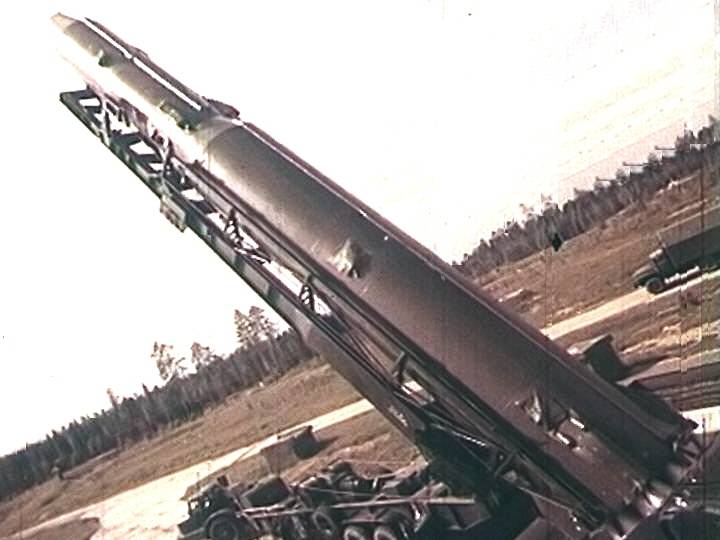
The “unified” R-16U rocket could be placed on an open launch pad and in a group launch silo launcher. The starting position united the three launch "glasses", the fuel storage and the underground command post. In 1963, the first regiments of domestic mine ICBMs were put on combat duty. In total, more than 200 ICBMs R-16U were delivered to the Strategic Missile Forces. The last missile of this type was removed from combat duty in 1976.
In July 1965, the R-9A ICBM was officially adopted. This rocket as well as the R-7 had engines running on kerosene and oxygen. The R-9A was significantly smaller and lighter than the R-7, but it had better operational properties. For the first time in the domestic practice of rocket science, R-9A used supercooled liquid oxygen, which reduced the refueling time to 20 minutes, and made the oxygen rocket competitive in terms of basic operational characteristics with R-16 ICBMs.
With a firing range of up to 12500 km, the R-9A missile was significantly lighter than the R-16. This was due to the fact that liquid oxygen made it possible to obtain higher characteristics than nitric acid oxidizers. In combat position, the R-9A weighed 80,4 tons. The cast weight was 1,6-2 tons. The missile was equipped with a thermonuclear warhead with a capacity of 1,65-2,5 Mt. A combined control system was installed on the rocket, which had an inertial system and a radio correction channel.
As in the case of the R-16 ICBMs, for the R-9A missiles, ground launching positions and silo launchers were built. The underground complex consisted of three mines located in one line, not far from each other, a command post, storage facilities for fuel and compressed gas components, a radio control center and technological equipment necessary to maintain a supply of liquid oxygen. All structures were connected by communication courses. The maximum number of missiles simultaneously on alert (1966-1967) was 29 units. Operation of the R-9A ICBMs was completed in 1976.
Although the first-generation Soviet ICBMs were very imperfect and had many shortcomings, they represented a real threat to the territory of the United States. Possessing low accuracy, the missiles carried megaton-class warheads and, in addition to destroying cities, could strike at area targets: large naval and air bases. According to information published in the literature on stories In 1965, the Strategic Missile Forces in the USSR had 234 ICBMs, after 5 years there were already 1421 units. In 1966, the deployment of the second-generation light ICBM UR-100 began, and in 1967 the heavy R-36 ICBM.
The massive construction of missile positions in the USSR in the mid-1960s did not go unnoticed by American intelligence. American naval analysts also predicted a possible early appearance in the Soviet fleet submarine nuclear missile carriers with ballistic missiles underwater launch. Already in the second half of the 1960s, the American leadership realized that in the event of a full-scale armed conflict with the USSR, not only military bases in Europe and Asia, but also the continental United States would be in the reach of Soviet strategic missiles. Although the American strategic potential was significantly greater than the Soviet one, the United States could no longer count on victory in a nuclear war.
Subsequently, this led to the fact that the leadership of the US Defense Ministry was forced to revise a number of key provisions of defense construction, and a number of programs that were previously considered priority were subjected to reduction or elimination. In particular, in the late 1960s, the landslide of the Nike-Hercules and Bomark positions began. By 1974, all MIM-14 Nike-Hercules long-range air defense systems, with the exception of positions in Florida and Alaska, were removed from combat duty. The last position in the United States was deactivated in 1979. The early-release stationary complexes were disposed of, and the mobile versions, after carrying out the restoration repair, were transferred to overseas American bases or transferred to the Allies.
In fairness, it should be said that MIM-14 missiles with nuclear warheads possessed some anti-missile capabilities. According to the calculation, the probability of hitting an attacking ICBM warhead was 0,1. By theoretically launching 10 missiles for one target, an acceptable probability of its interception could be achieved. However, to put it into practice was impossible. It was not even that the hardware of the Nike-Hercules air defense system could not simultaneously direct such a quantity of missiles. If desired, this problem could be solved, but after a nuclear explosion formed a vast area inaccessible to radar, which made it impossible to direct other missile interceptors.
If the later modifications of the MIM-14 Nike-Hercules air defense system continued to serve outside the United States, and the latest systems of this type were removed in Italy and South Korea in the early 21st century, and in Turkey they are still formally in service, then the career of CIM unmanned interceptors -10 Bomars was not long. Simulation of conflict scenarios in the conditions of striking the USA with Soviet ICBMs and SLBMs showed that the combat stability of the SAGE automated guidance system will be very low. Partial or complete loss of operability of even one link of this system, which included guidance radars, computer centers, communication lines and command transmission stations, inevitably led to the impossibility of withdrawing interceptors to the target area.
The decontamination of the Bomark launch complexes began in 1968, and in 1972 they were all closed. CIM-10V removed from combat duty after dismantling warheads from them and installing a remote control system using radio commands were operated in the 4571th squadron of unmanned targets until 1979. Converted into radio-controlled targets, unmanned interceptors imitated Soviet supersonic cruise missiles during the exercises.
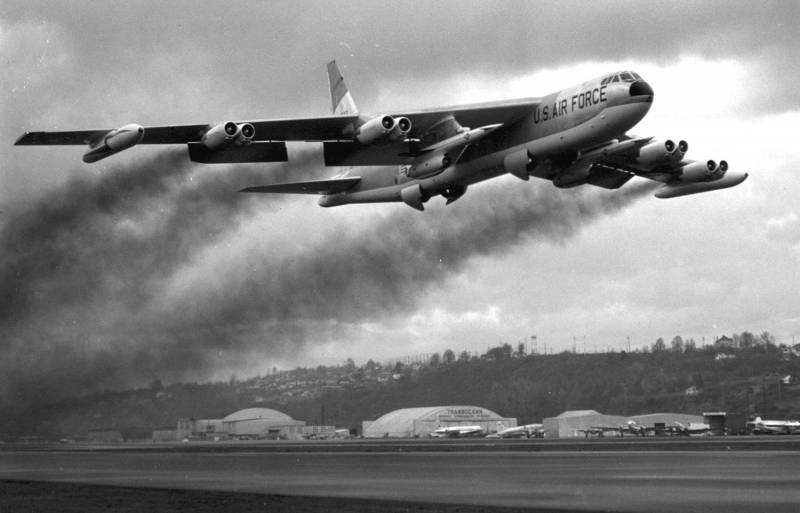
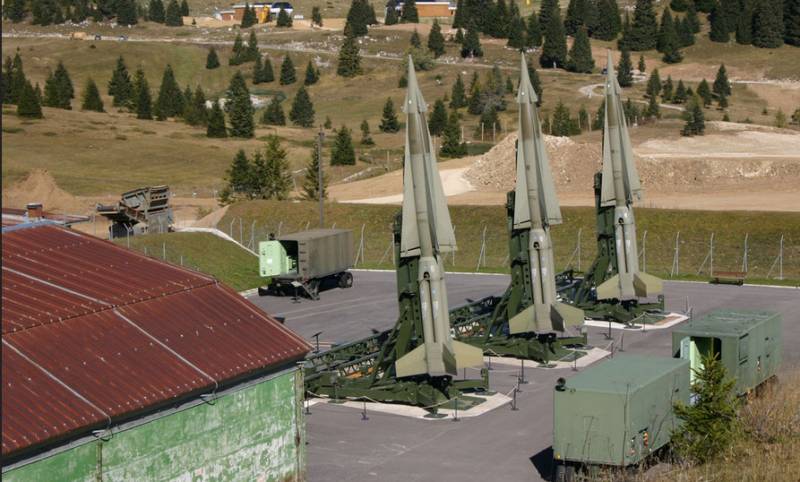
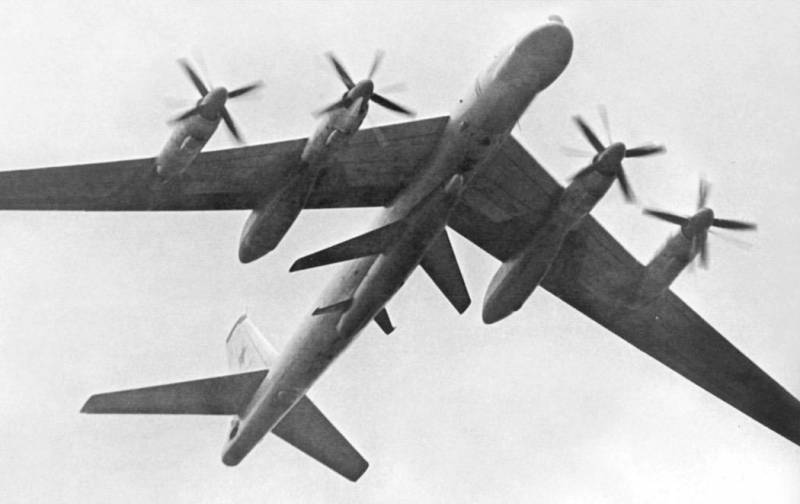
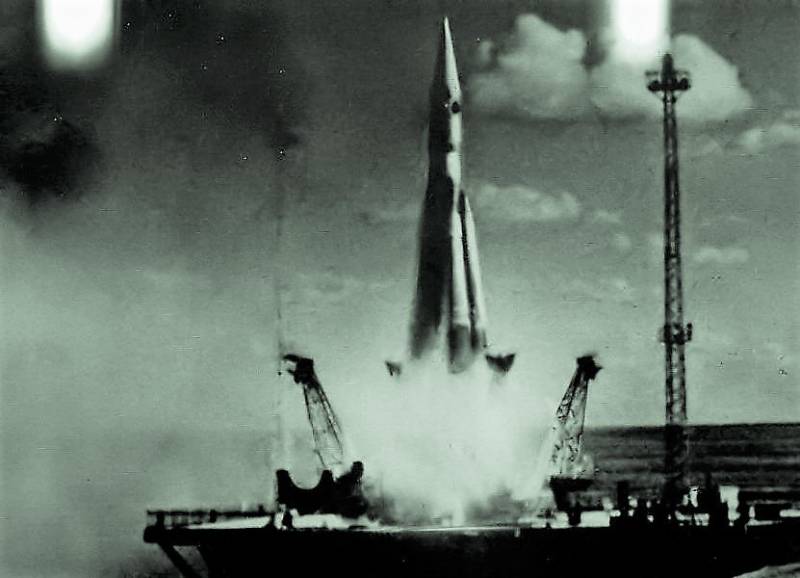
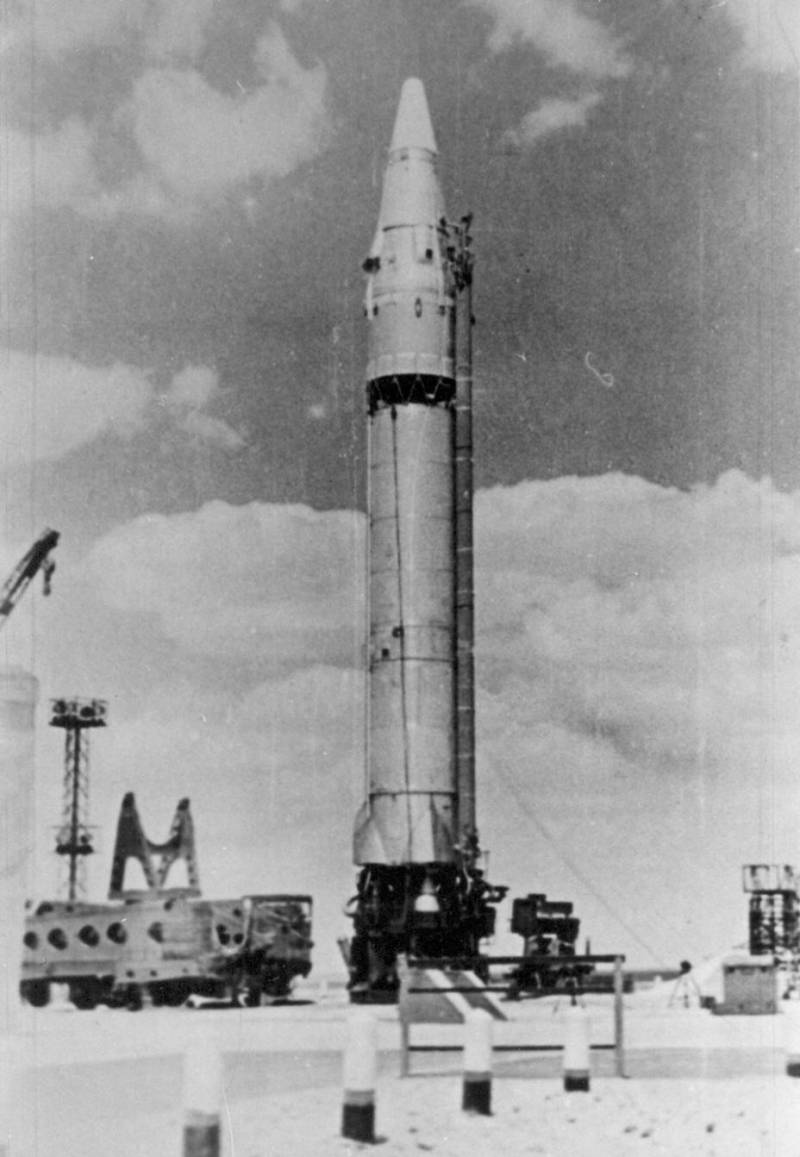
Information